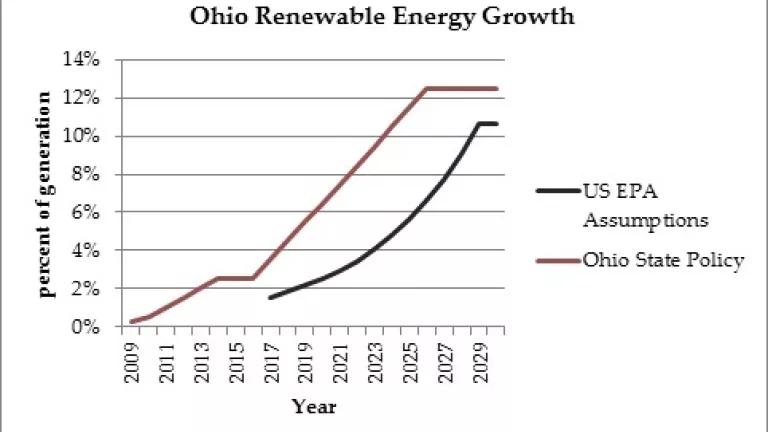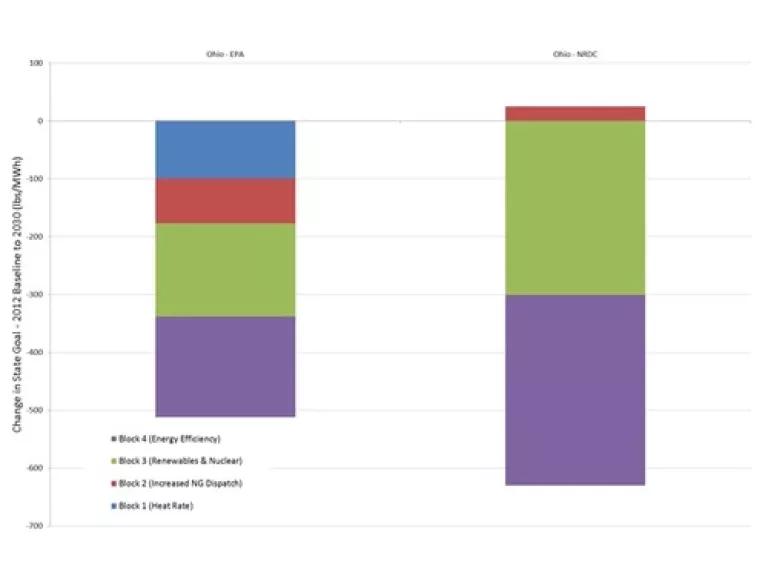US EPA Carbon Rules Comment Period Extended, But There's No Need to Delay Ohio's Clean Energy Standards

Although the U.S. Environmental Protection Agency announced on Tuesday that it’s extending the comment period on the Clean Power Plan for states to curb carbon emissions from our nation’s power fleet to Dec. 1, Ohio doesn’t need additional time to ponder the benefits of its clean energy standards.
Just this week, NRDC submitted comments to the Ohio Environmental Protection Agency and the Public Utilities Commission of Ohio, focusing on the state’s potential to cut carbon emissions primarily through clean energy sources.
And our findings are encouraging.
Efficiency and Renewables are Key to Meeting Ohio’s Carbon Target
Thanks to Ohio’s energy efficiency and renewables requirements, which were passed almost five years ago under SB 221, the state is on the path to source more than 20 million megawatt hours (MWh) of electricity from renewable sources and to deploy over 37 million cumulative MWh of energy efficiency to the grid by 2030. In fact, assuming Ohio’s clean energy policies are reinstated in 2017 after the SB 310 freeze ends, Ohio will have these resources in such abundance that it is projected to exceed EPA's projections at least five years ahead of schedule.
These findings undermine media chatter over the last few months that would have you believe such a coal-intensive state as Ohio cannot significantly cut carbon. Not so.
Our analysis demonstrates that Ohio’s carbon reductions target is achievable and can be met through exceedingly cost-effective clean energy resources. And these resources provide more bang for the buck because they have already spelled billions of dollars in energy bill savings for Ohioans and supported a fast-growing economy, all while helping to reduce the harmful carbon emissions that threaten public health and the environment.
These are powerful tools that represent a vast well of untapped opportunity to displace carbon-intensive resources. And NRDC’s findings illustrate just how deep that well is.
A Crash Course in Ohio’s Carbon Target
On June 2, 2014, the U.S. EPA proposed the first-ever standards regulating carbon emissions from power plants – the nation’s single biggest source of the pollution contributing to global warming. In Ohio, the electric power sector accounts for approximately 100 million metric tons of carbon dioxide emitted into the air annually. While we already limit how much arsenic, mercury, and soot our electricity-generating power plants emit, there have been no such limits for carbon pollution.
The Clean Power Plan is a flexible approach that allows significant emissions reductions at low cost. It draws on a range of tools that have been proven to cut carbon pollution, based on four main categories, or “building blocks.” These blocks were used to set the target for every state and include:
- heat rate improvements at coal plants;
- ramped up natural gas plant dispatch;
- renewable energy resources; and
- ramped-up energy efficiency.
I described back in June how these tools were used to calculate Ohio’s 2030 target. The key blocks proposed for Ohio (and many other states) are renewables and energy efficiency. While EPA relied on the four block to develop the targets, states do not have to take those precise steps to get to the finish line. Rather, Ohio has the opportunity to focus exclusively on efficiency and renewables for its compliance plan.
And based on our analysis, EPA has vastly underestimated Ohio’s potential to use these tools for carbon reduction, rendering Ohio’s target eminently achievable - and at low-cost.
Just How Far Can Ohio’s Clean Energy Standards Get the State to Compliance?
To illustrate just how conservative EPA’s assumptions in setting Ohio’s targets were, consider that EPA incorporated very modest assumptions for the expansion of renewable energy, based on what states in each region have already committed to achieve. For Ohio, EPA assumed an initial renewable generation level of 1.6% in 2017, growing to 10.6% of total generation by 2029 and thereafter.
But when you compare this with the renewables requirement that Ohio already has in place and the state’s planned ramp-up, the state is on track to reach the 2030 level of renewables generation assumed by EPA at least seven years ahead of schedule. The table below shows the vast divide in EPA’s projection.
EPA’s Renewable Assumptions vs. Ohio’s Requirement (% of generation)
Now consider the energy efficiency block, the fourth tool in EPA’s target-setting.
In this block, the Clean Power Plan assumed states will expand their energy efficiency efforts at a very modest rate—1.5% annual savings—and built in a gradual ramp-up to these savings that starts in 2017 with 0.2% per year. For Ohio, EPA assumed the state would begin in 2017 by achieving 0.85% energy savings through efficiency and reach 1.5% by 2021 and thereafter.
But again, these assumptions vastly underestimate Ohio’s commitment to efficiency. In fact, assuming Ohio’s clean energy policies remain in place, the state is on track to achieve the 2030 cumulative energy efficiency savings assumed by EPA at least five years ahead of schedule.
EPA Efficiency Assumptions vs. Ohio’s Requirement (cumulative savings in MWh)

And the potential doesn’t end there. Not only is the efficiency ramp-up underestimated in the state’s carbon target, EPA also assumed Ohio’s efficiency investments would be more costly and not endure as long as the real programs currently run by Ohio’s utilities.
Thus, Ohio can get carbon reductions through efficiency that last longer and are even cheaper than EPA projected.
Isn’t Ohio Also Required to Cut Carbon at Coal Plants and by Ramping up Natural Gas?
Actually, no. EPA does not prescribe how a state should meet its goal. It is important to keep this fact in mind when considering comments like American Electric Power’s this week, in which they expressed concern over the assumptions in Blocks 1 (heat rate improvements) and 2 (natural gas plant ramp-up) of the carbon targets.
Instead, Ohio can develop its plan any way it sees fit.
If Ohio is seeking the most cost-effective path forward, consider another parallel analysis that NRDC included in our comments this week. We took our above analysis one step further and asked whether Ohio could focus its carbon plan exclusively on efficiency and renewables and still meet the 2030 target.
The answer is yes.
Even assuming Ohio foregoes carbon reductions through heat improvements (Block 1) or ramped-up natural gas (Block 2), if the state fully implements its efficiency and renewables requirements it has the potential to exceed the 2030 emissions target.
Change in State Goal from 2012 Baseline to 2030 Target (EPA Assumptions Vs. Ohio Focus on Efficiency and Renewables)

Ohio Can Hit its Carbon Target
Our analysis confirms that Ohio’s carbon target is achievable and solely with clean energy resources. Thanks to its commitment to efficiency and renewable energy and the progress made on these fronts in the last five years, the state has these resources in such abundance that it could exceed EPA’s assumptions years ahead of schedule.
Assuming its clean energy policies are reinstated in 2017, Ohio has the opportunity to achieve deep carbon reductions that will help it hit the targets proposed in the Clean Power Plan and be a leader in the Midwest for constructively and cost-effectively crafting a smart compliance plan.
